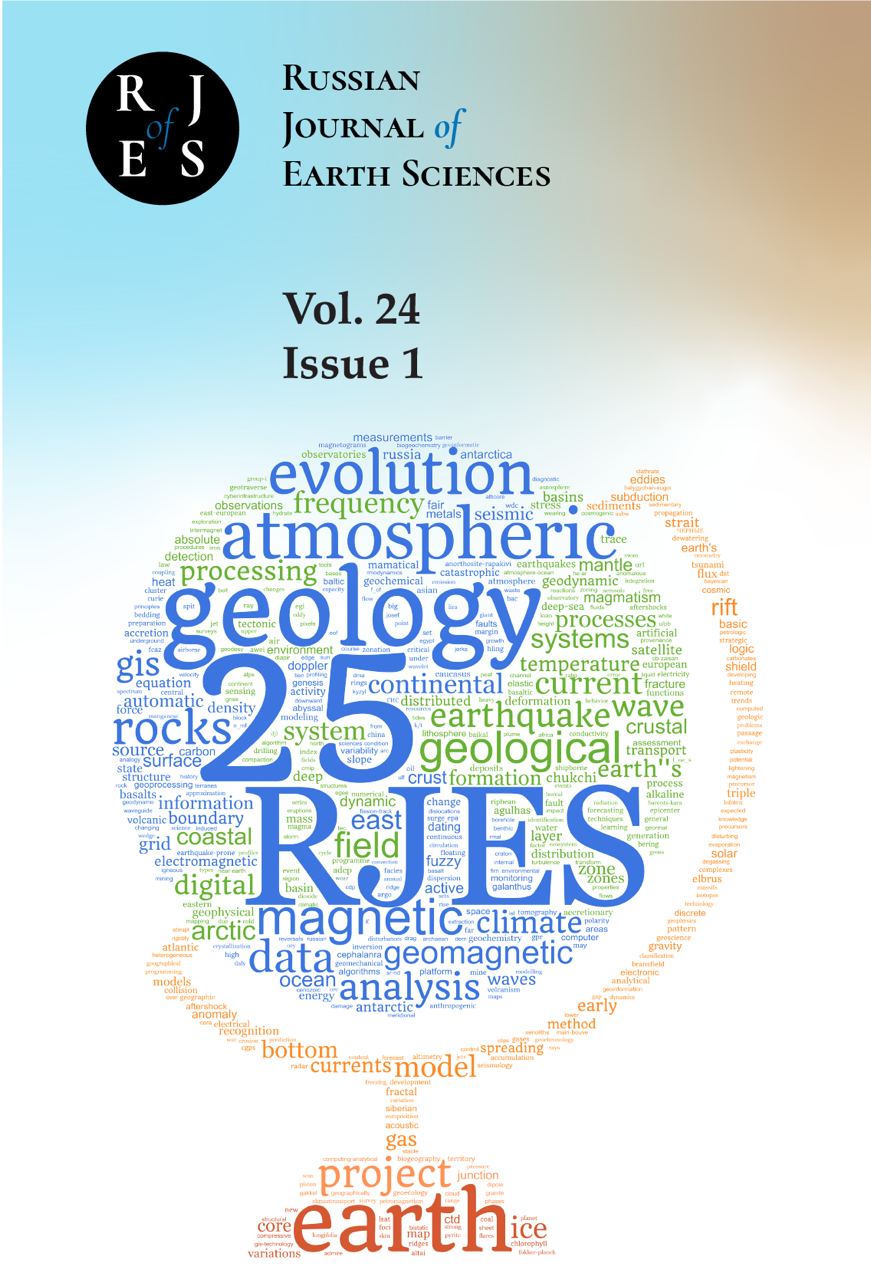Москва, Россия
УДК 55 Геология. Геологические и геофизические науки
ГРНТИ 38.00 ГЕОЛОГИЯ
ГРНТИ 37.00 ГЕОФИЗИКА
ОКСО 05.00.00 Науки о Земле
ББК 26 Науки о Земле
ТБК 63 Науки о Земле. Экология
BISAC SCI SCIENCE
The Eastern Paratethys Konkian sedimentary successions of the Zelensky section (Taman peninsula, Russia) were investigated by cyclostratigraphy methods based on magnetic susceptibility measurements. Cyclostratigraphy is a new scientific direction in stratigraphy and sedimentology, the purpose of which is to identify astronomical cyclicity for the reconstruction geochronology using high-precision technologies. Time series analysis (Lomb-Scargle and REDFIT periodograms, wavelet) revealed statistically significant signals corresponding most likely to long-term insolation periodicities in studied sediments. In the deep-water Konkian sediments of the Zelensky section, the signal at 3.3 m corresponds to the 100-kyr eccentricity cycle. The astronomically tuned these sediments result in an average sedimentation rate of about 3.3 cm/kyr with the duration of accumulation of the Sartaganian and Veselyankian beds about 200 kyr. The obtained cyclostratigraphic results generally do not contradict the new data about the possible duration of the Konkian (Kartvelian, Sartaganian and Veselyankian beds) of about 750 kyr [Palcu et al., 2017].
Eastern Paratethys, Konkian, Taman peninsula, Zelensky section, cyclostratigraphy, magnetic susceptibility
1. Andrusov, N. (1903), Geological research at the Taman Peninsula, Materials for the Geology of Russia, 21(2), 257–383 (in Russian).
2. Belokrys, L. S. (1987), On the main criterion for the regional stratigraphic division of Miocene deposits from the Black Sea-Caspian basin, in Collection Scientific Works: Stratigraphy of the Cenozoic of the Northern Black Sea and Crimea, pp. 7–20, Dnepropetrovsk State University, Dnepropetrovsk (in Russian).
3. Gladenkov, Yu. B. (2004), Biosphere stratigraphy (stratigraphic problems in the early XXI century), GEOS (in Russian), EDN: https://elibrary.ru/QKDTIX.
4. Hammer, O., D. A. T. Harper, and P. D. Ryan (2001), Past: paleontological statistics software package for education and data analysis, Palaeontologia Electronica, 4(1), 1–9.
5. Hilgen, F. J., L. J. Lourens, J. A. Van Dam, A. G. Beu, A. F. Boyes, R. A. Cooper, W. Krijgsman, J. G. Ogg, W. E. Piller, and D. S. Wilson (2012), The Neogene Period, pp. 923–978, Elsevier, https://doi.org/10.1016/B978-0-444-59425-9.00029-9. EDN: https://elibrary.ru/UOQKBD
6. Il’ina, L. B. (2000), On the regional Konkian Stage (Middle Miocene) in the Eastern Paratethys, Stratigraphy and Geological Correlation, 8(4), 372–377. EDN: https://elibrary.ru/LGDNHT
7. Jgenti, E. M., and L. S. Maissuradze (2016), Karaganian, Kartvelian, and Konkian Regional Stages in Georgia: Evolution of Mollusks and Foraminifers and Their Stratigraphic Significance, National museum of Georgia, Tbilisi (in Russian).
8. Merklin, R. L. (1953), Stages of development of the Konkian basin in the Miocene of the south of the USSR, Bulletin of the Moscow Society of Naturalists, 28(3), 89–91 (in Russian).
9. Nevesskaja, L. A., E. I. Kovalenko, E. V. Beluzhenko, S. Popov, I. Goncharova, G. Danukalova, I. J. Zhidovinov, A. V. Zaitsev, A. S. Zaztrozhnov, L. B. Ilyina, T. Pinchuk, N. S. Pismennaya, A. Agadjanyan, A. V. Lopatin, and V. M. Trubikhin (2004), Explanatory Note to the Unified Regional Stratigraphic Scheme of Neogene Deposits in the Southern European Part of Russia, Paleontological Institute RAS, Moscow (in Russian).
10. Palcu, D. V., L. A. Golovina, Y. V. Vernyhorova, S. V. Popov, and W. Krijgsman (2017), Middle Miocene paleoenvironmental crises in Central Eurasia caused by changes in marine gateway configuration, Global and Planetary Change, 158, 57–71, https://doi.org/10.1016/j.gloplacha.2017.09.013. EDN: https://elibrary.ru/XOBXFS
11. Popov, S. V., M. A. Akhmetiev, L. A. Golovina, I. A. Goncharova, E. P. Radionova, N. Yu. Filippova, and V. M. Trubichin (2013), Neogene Regiostage Stratigraphic Scale of the South Russia: Current State and Perspectives, in General Stratigraphic Scale of Russia: Current State and Ways of Perfection. All-Russian conference. Moscow, May 23–25, 2013, pp. 356–539, GIN RAS, Moscow (in Russian).
12. Popov, S. V., Yu. V. Rostovtseva, N. Y. Fillippova, L. A. Golovina, E. P. Radionova, I. A. Goncharova, Yu. V. Vernyhorova, N. I. Dykan, T. N. Pinchuk, L. B. Iljina, A. V. Koromyslova, T. M. Kozyrenko, I. A. Nikolaeva, and L. A. Viskova (2016), Paleontology and stratigraphy of the Middle-Upper Miocene of the Taman Peninsula: Part 1. Description of key sections and benthic fossil groups, Paleontological Journal, 50(10), 1039–1206, https://doi.org/10.1134/S0031030116100014. EDN: https://elibrary.ru/YVABMV
13. Rostovtseva, Yu. V., A. I. Rybkina, and A. Yu. Sokolova (2019), The Depositional Setting of the Konkian Sediments of the Taman Peninsula, Moscow University Geology Bulletin, 74(1), 50–55, https://doi.org/10.3103/S0145875219010101. EDN: https://elibrary.ru/CPYTBP
14. Schulz, M., and M. Mudelsee (2002), REDFIT: estimating red-noise spectra directly from unevenly spaced paleoclimatic time series, Computers & Geosciences, 28(3), 421–426, https://doi.org/10.1016/S0098-3004(01)00044-9.
15. Vernigorova, Yu. V., L. A. Golovina, and I. A. Goncharova (2006), On the characteristics of the Konkian deposits of the Taman Peninsula, Biostratigraphic Criteria for Subdivision and Correlation of Phanerozoic Deposits of Ukraine, pp. 231–242 (in Russian).
16. Vernyhorova, Y. V. (2017), Middle Miocene (Konkian of the Eastern Paratethys) foraminifera assemblages from the Southern Ukraine, in 7 th International Workshop "Neogene of Central and South Eastern Europe", https://doi.org/10.13140/RG.2.2.34298.90560.
17. Weedon, G. P. (2003), Time-Series Analysis and Cyclostratigraphy: Examining Stratigraphic Records of Environmental Cycles, Cambridge University Press, https://doi.org/10.1017/CBO9780511535482.
















